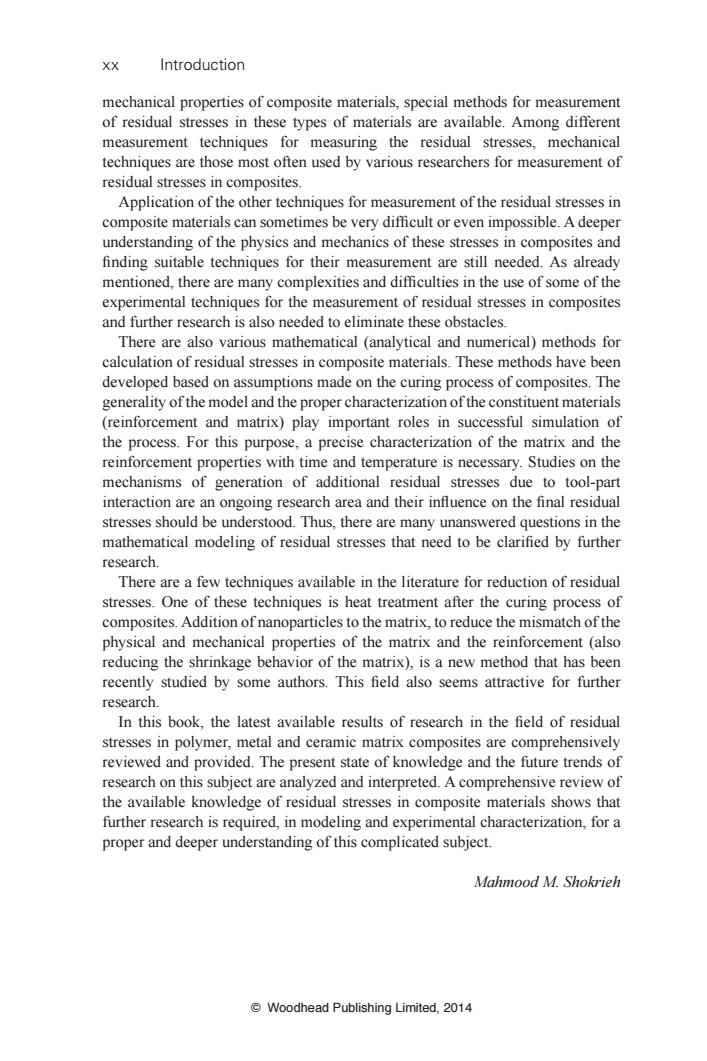正在加载图片...

XX Introduction mechanical properties of composite materials,special methods for measurement of residual stresses in these types of materials are available.Among different measurement techniques for measuring the residual stresses,mechanical techniques are those most often used by various researchers for measurement of residual stresses in composites. Application of the other techniques for measurement of the residual stresses in composite materials can sometimes be very difficult or even impossible.A deeper understanding of the physics and mechanics of these stresses in composites and finding suitable techniques for their measurement are still needed.As already mentioned,there are many complexities and difficulties in the use of some of the experimental techniques for the measurement of residual stresses in composites and further research is also needed to eliminate these obstacles. There are also various mathematical (analytical and numerical)methods for calculation of residual stresses in composite materials.These methods have been developed based on assumptions made on the curing process of composites.The generality of the model and the proper characterization of the constituent materials (reinforcement and matrix)play important roles in successful simulation of the process.For this purpose,a precise characterization of the matrix and the reinforcement properties with time and temperature is necessary.Studies on the mechanisms of generation of additional residual stresses due to tool-part interaction are an ongoing research area and their influence on the final residual stresses should be understood.Thus,there are many unanswered questions in the mathematical modeling of residual stresses that need to be clarified by further research. There are a few techniques available in the literature for reduction of residual stresses.One of these techniques is heat treatment after the curing process of composites.Addition of nanoparticles to the matrix,to reduce the mismatch of the physical and mechanical properties of the matrix and the reinforcement(also reducing the shrinkage behavior of the matrix),is a new method that has been recently studied by some authors.This field also seems attractive for further research. In this book,the latest available results of research in the field of residual stresses in polymer,metal and ceramic matrix composites are comprehensively reviewed and provided.The present state of knowledge and the future trends of research on this subject are analyzed and interpreted.A comprehensive review of the available knowledge of residual stresses in composite materials shows that further research is required,in modeling and experimental characterization,for a proper and deeper understanding of this complicated subject Mahmood M.Shokrieh Woodhead Publishing Limited,2014© Woodhead Publishing Limited, 2014 xx Introduction mechanical properties of composite materials, special methods for measurement of residual stresses in these types of materials are available. Among different measurement techniques for measuring the residual stresses, mechanical techniques are those most often used by various researchers for measurement of residual stresses in composites. Application of the other techniques for measurement of the residual stresses in composite materials can sometimes be very diffi cult or even impossible. A deeper understanding of the physics and mechanics of these stresses in composites and fi nding suitable techniques for their measurement are still needed. As already mentioned, there are many complexities and diffi culties in the use of some of the experimental techniques for the measurement of residual stresses in composites and further research is also needed to eliminate these obstacles. There are also various mathematical (analytical and numerical) methods for calculation of residual stresses in composite materials. These methods have been developed based on assumptions made on the curing process of composites. The generality of the model and the proper characterization of the constituent materials (reinforcement and matrix) play important roles in successful simulation of the process. For this purpose, a precise characterization of the matrix and the reinforcement properties with time and temperature is necessary. Studies on the mechanisms of generation of additional residual stresses due to tool- part interaction are an ongoing research area and their infl uence on the fi nal residual stresses should be understood. Thus, there are many unanswered questions in the mathematical modeling of residual stresses that need to be clarifi ed by further research. There are a few techniques available in the literature for reduction of residual stresses. One of these techniques is heat treatment after the curing process of composites. Addition of nanoparticles to the matrix, to reduce the mismatch of the physical and mechanical properties of the matrix and the reinforcement (also reducing the shrinkage behavior of the matrix), is a new method that has been recently studied by some authors. This fi eld also seems attractive for further research. In this book, the latest available results of research in the fi eld of residual stresses in polymer, metal and ceramic matrix composites are comprehensively reviewed and provided. The present state of knowledge and the future trends of research on this subject are analyzed and interpreted. A comprehensive review of the available knowledge of residual stresses in composite materials shows that further research is required, in modeling and experimental characterization, for a proper and deeper understanding of this complicated subject. Mahmood M. Shokrieh